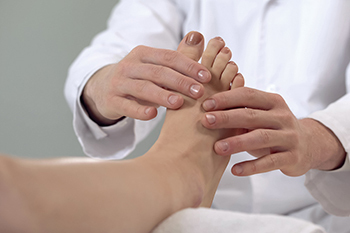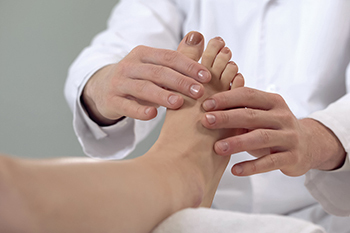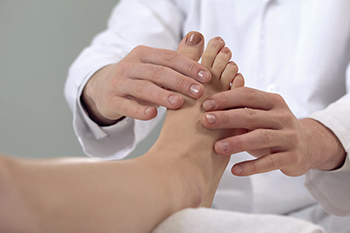Baytown, TX (281) 837-8371
September 2022
Causes and Effects of Drop Foot

Drop foot is caused by an inability to lift the foot enough to clear the ground as you take a step. It results in a shuffling or dragging type of gait. To counteract that, a person tends to over-lift the knees on each step, resembling a marching gait. Experts find that drop foot is usually a sign that something else is wrong. Causes may be anatomical, muscular, or neurological. Nerve injury, such as damage to the peroneal nerve, is a common cause of drop foot. Symptoms are pain and numbness. It may be brought on by a sports injury, childbirth, or sitting with your legs crossed for a long time. Certain muscle disorders like muscular dystrophy may also be the cause. Electronic imaging tests can be used to detect the underlying cause behind drop foot and treatment options depend on the source of the problem. Many find that custom orthotics, light braces, nerve stimulation, and possible surgery can be helpful. For more information on drop foot and how it may be treated, please consult a podiatrist.
If you have any concerns about your feet, contact Abeer M. Foteh, DPM from Greater Houston Foot Centers. Our doctor can provide the care you need to keep you pain-free and on your feet.
Biomechanics in Podiatry
Podiatric biomechanics is a particular sector of specialty podiatry with licensed practitioners who are trained to diagnose and treat conditions affecting the foot, ankle and lower leg. Biomechanics deals with the forces that act against the body, causing an interference with the biological structures. It focuses on the movement of the ankle, the foot and the forces that interact with them.
A History of Biomechanics
- Biomechanics dates back to the BC era in Egypt where evidence of professional foot care has been recorded.
- In 1974, biomechanics gained a higher profile from the studies of Merton Root, who claimed that by changing or controlling the forces between the ankle and the foot, corrections or conditions could be implemented to gain strength and coordination in the area.
Modern technological improvements are based on past theories and therapeutic processes that provide a better understanding of podiatric concepts for biomechanics. Computers can provide accurate information about the forces and patterns of the feet and lower legs.
Understanding biomechanics of the feet can help improve and eliminate pain, stopping further stress to the foot.
If you have any questions please feel free to contact our office located in Baytown, TX . We offer the newest diagnostic and treatment technologies for all your foot and ankle needs.
Do You Work on Your Feet?

Many people who work on their feet for most of the day understand the importance of resting their feet briefly during a scheduled break before returning to their duties at work. This can include many professions including the restaurant industry, medical personnel, and retail workers. There are several foot conditions that can result from standing all day. Plantar fasciitis, poor circulation, bunions, and foot arthritis are a few examples. It is extremely beneficial to wear shoes that fit correctly and are comfortable. It is essential to choose shoes that have a good support system and avoid shoes that are flat like flip-flops or ballet shoes. Additionally, it is suggested to refrain from wearing shoes that will push the toes forward which can move the center of gravity. Many people wear compression socks as this can be helpful in controlling circulation. When the workday is over, many people understand the pleasure of soaking their feet in warm water since this is helpful in reducing pain and inflammation. If you would like more information about how to protect the feet while working or standing all day, please consult with a podiatrist who can answer any questions you may have.
While working on the feet, it is important to take the proper care of them. For more information about working on your feet, contact Abeer M. Foteh, DPM from Greater Houston Foot Centers. Our doctor will treat your foot and ankle needs.
Working on Your Feet
Standing on your feet for long periods of time can cause stress and pain in your feet. Your whole body may experience change in terms of posture, back pain, bunions, callouses and or plantar warts. There are ways to avoid these conditions with proper foot care, smart choices and correct posture.
Positive Changes
Negative heeled shoe – Choosing this shoe type places the heel slightly lower than the ball of the foot. These are great for overall foot health. Find shoes that fit you correctly.
Go barefoot – Our feet were not designed to be enclosed for all hours of the day. Try to periodically expose your feet to air.
Eliminate Pain
Foot Exercises – Performing simple exercises, incorporating yoga and doing stretches are beneficial. This will allow increased blood flow to the area and muscles of the foot.
Achilles tendon – Stretching the foot out flat on the floor will relax the calf muscles and tendon. These exercises can be performed almost anywhere. Make sure you add these exercises to your daily regimen.
With a little bit of this information and knowing more about foot health, you will notice changes. Foot stretches and proper footwear will help with pain and prevent further issues.
If you have any questions please feel free to contact our office located in Baytown, TX . We offer the newest diagnostic and treatment technologies for all your foot and ankle needs.
Laser Treatment May Help Toenail Fungus

Research has shown toenail fungus may be prevalent among the elderly population. There are several methods that can be implemented to treat toenail fungus, including laser treatment. This is a procedure that has been approved by the FDA and is said that it may be effective in killing the fungus as laser beams penetrate the nail bed. It is a painless procedure and many patients have had good results, but they could vary. Toenail fungus can be unsightly, and the symptoms generally consist of yellowed, thickened nails that often become brittle with the possibility of falling off. Patients who have toenail fungus are often embarrassed by their toenails and tend to hide their feet. If you have this condition and would like more information about the pros and cons of laser treatment, it is strongly advised that you schedule an appointment with a podiatrist who can answer any questions you may have.
Laser treatment can be an effective way to get rid of toenail fungus. If you have any questions about laser treatment, consult with Abeer M. Foteh, DPM from Greater Houston Foot Centers. Our doctor will assess your condition and provide you with quality treatment for fungal nails.
What Are Toenail Fungal Infections?
Onychomycosis, or fungal infection of the nail, is a relatively common and non-serious condition. Around 10 percent of U.S. citizens are afflicted with fungal nails. Common forms of fungus that infect the nail include dermatophytes, yeasts, and molds.
Symptoms of Toenail Fungal Infections Include:
- Nail thickening
- Brittleness of the nail
- Discoloration of the nail
Diagnosis for Fungal Nails
Fungal infections are diagnosed by fungal culture and microscopy. This will rule out any other conditions such as nail trauma, psoriasis, lichen planus, and onychogryphosis.
What Is Laser Treatment?
Laser treatment is a non-invasive, safe, quick, and painless procedure that uses the heat from a laser to kill fungus in the nail. Each infected nail is targeted with a laser for several minutes. The treatment is usually utilized several different times over a select period. During this time, a podiatrist will keep an eye on the infection.
If you have any questions, please feel free to contact our office located in Baytown, TX . We offer the newest diagnostic and treatment technologies for all your foot care needs.
Reminder: When Was the Last Time...?
Causes of Achilles Tendon Pain

Pain in the back of the heel is very common in sports, usually signals overuse, and mostly concerns the Achilles tendon. Most common is Achilles tendonitis, which usually starts with a mild ache, but with increased and prolonged activity can develop into severe pain. This injury, an inflammation of the Achilles tendon which connects the calf muscles to the heel bone, is common among runners. Another cause of Achilles tendon pain is Sever’s disease, which occurs in adolescent children who are active in sports. It is the result of an imbalance in the growth rate of the calf muscle and the heel bone, but usually self-corrects with time. Achilles bursitis, also known as retrocalcaneal bursitis, is an inflammation of a small sac of fluid in the back of the heel called a bursa. Another overuse injury, it will cause pain, swelling, and tenderness. An Achilles tendon rupture indicates a complete tear, and most commonly occurs in men over the age of 40. A loud snapping noise accompanies this injury, which is often described as being struck on the back of the heel. Immediate attention to this injury is suggested. If you experience any of the above injuries, it is wise to visit a podiatrist for an exam and diagnosis.
Achilles tendon injuries need immediate attention to avoid future complications. If you have any concerns, contact Abeer M. Foteh, DPM of Greater Houston Foot Centers. Our doctor can provide the care you need to keep you pain-free and on your feet.
What Is the Achilles Tendon?
The Achilles tendon is a tendon that connects the lower leg muscles and calf to the heel of the foot. It is the strongest tendon in the human body and is essential for making movement possible. Because this tendon is such an integral part of the body, any injuries to it can create immense difficulties and should immediately be presented to a doctor.
What Are the Symptoms of an Achilles Tendon Injury?
There are various types of injuries that can affect the Achilles tendon. The two most common injuries are Achilles tendinitis and ruptures of the tendon.
Achilles Tendinitis Symptoms
- Inflammation
- Dull to severe pain
- Increased blood flow to the tendon
- Thickening of the tendon
Rupture Symptoms
- Extreme pain and swelling in the foot
- Total immobility
Treatment and Prevention
Achilles tendon injuries are diagnosed by a thorough physical evaluation, which can include an MRI. Treatment involves rest, physical therapy, and in some cases, surgery. However, various preventative measures can be taken to avoid these injuries, such as:
- Thorough stretching of the tendon before and after exercise
- Strengthening exercises like calf raises, squats, leg curls, leg extensions, leg raises, lunges, and leg presses
If you have any questions please feel free to contact our office located in Baytown, TX . We offer the newest diagnostic tools and technology to treat your foot and ankle needs.








